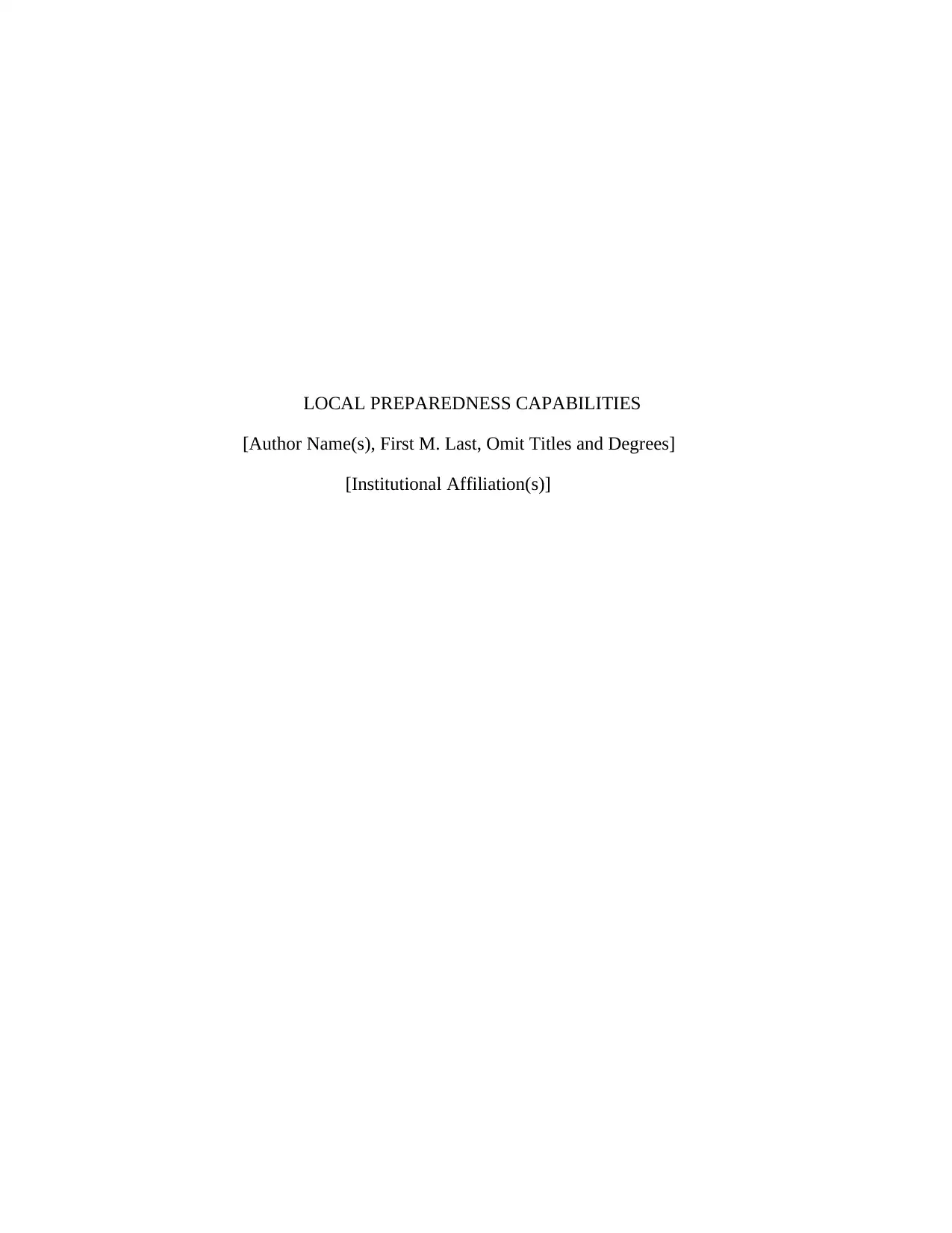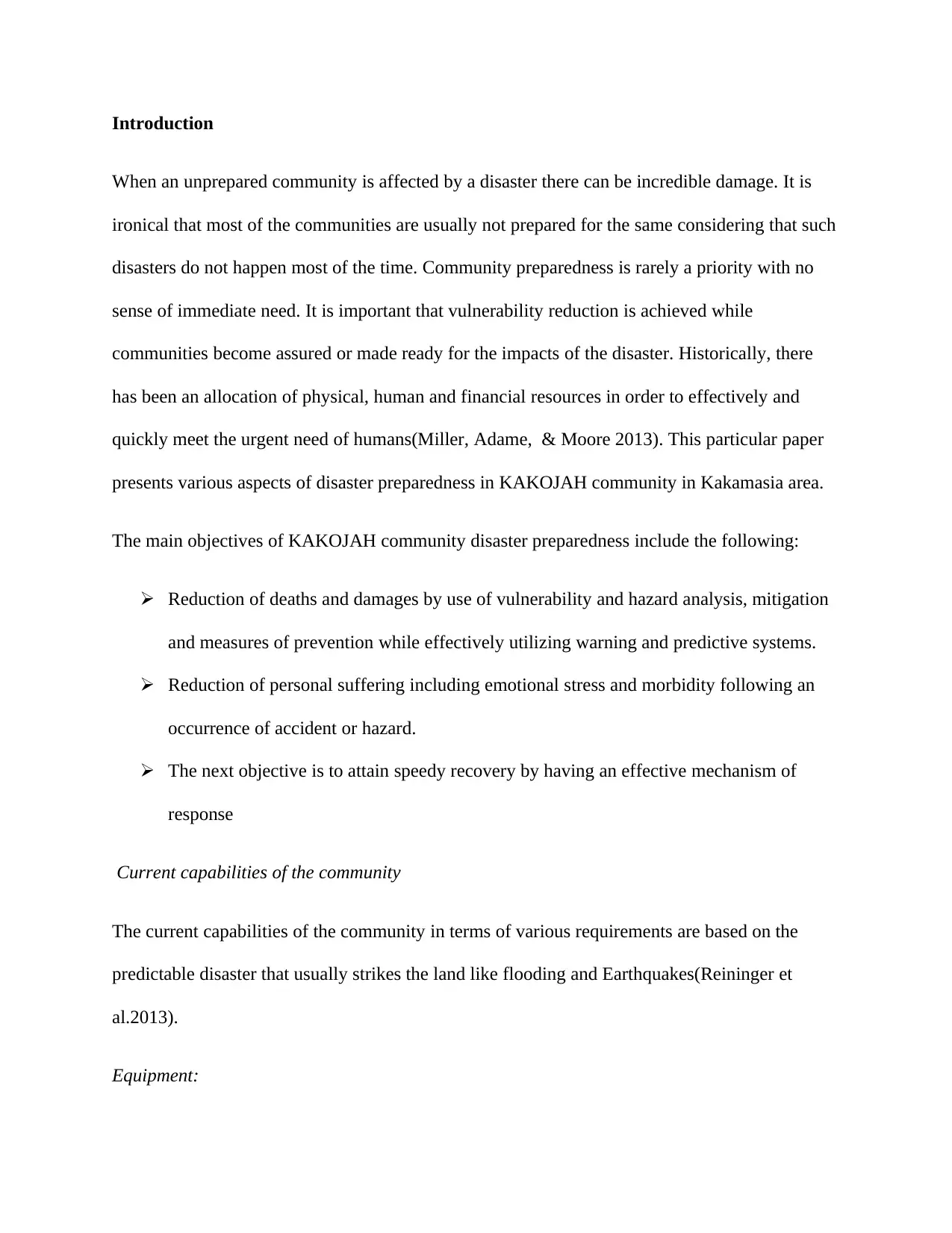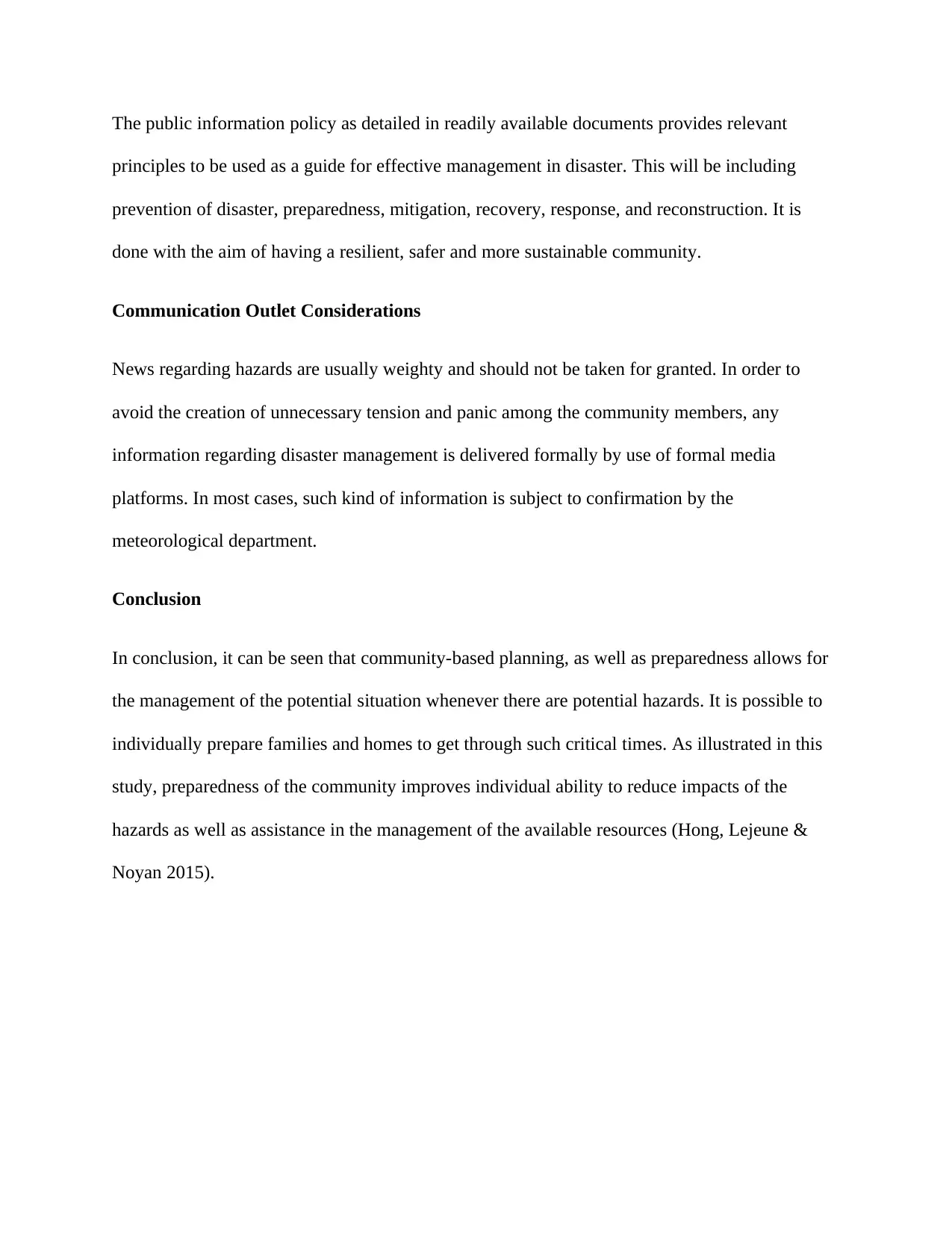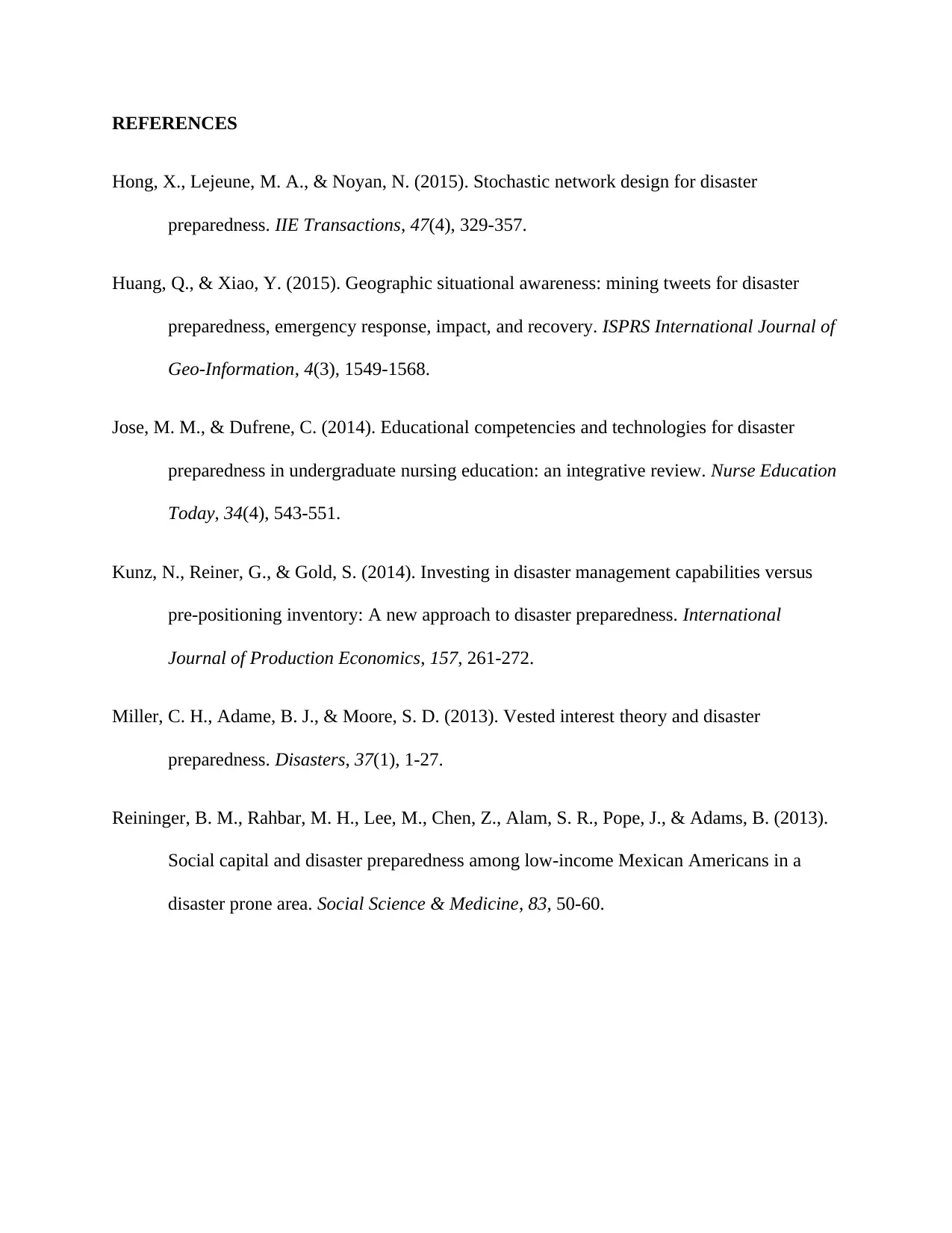Assessment of Local Preparedness Capabilities: KAKOJAH Community
VerifiedAdded on 2022/11/18
|6
|1156
|432
Report
AI Summary
This report presents an assessment of disaster preparedness capabilities within the KAKOJAH community, focusing on the reduction of deaths, damages, and personal suffering during disasters like floods and earthquakes. It details current resources, including equipment like hydro snakes and air brick covers, manpower, training programs, and funding sources. The report identifies geographical challenges, such as poorly drained soil, and proposes strategies to enhance civic preparedness, including trench digging, tree planting, and public awareness campaigns using meteorological department weather predictions. It emphasizes the importance of official approval for emergency teams, public information policies, and formal communication channels. The conclusion highlights the value of community-based planning and preparedness in managing potential hazards and improving the community's ability to reduce disaster impacts and manage resources effectively.

LOCAL PREPAREDNESS CAPABILITIES
[Author Name(s), First M. Last, Omit Titles and Degrees]
[Institutional Affiliation(s)]
[Author Name(s), First M. Last, Omit Titles and Degrees]
[Institutional Affiliation(s)]
Paraphrase This Document
Need a fresh take? Get an instant paraphrase of this document with our AI Paraphraser

Introduction
When an unprepared community is affected by a disaster there can be incredible damage. It is
ironical that most of the communities are usually not prepared for the same considering that such
disasters do not happen most of the time. Community preparedness is rarely a priority with no
sense of immediate need. It is important that vulnerability reduction is achieved while
communities become assured or made ready for the impacts of the disaster. Historically, there
has been an allocation of physical, human and financial resources in order to effectively and
quickly meet the urgent need of humans(Miller, Adame, & Moore 2013). This particular paper
presents various aspects of disaster preparedness in KAKOJAH community in Kakamasia area.
The main objectives of KAKOJAH community disaster preparedness include the following:
Reduction of deaths and damages by use of vulnerability and hazard analysis, mitigation
and measures of prevention while effectively utilizing warning and predictive systems.
Reduction of personal suffering including emotional stress and morbidity following an
occurrence of accident or hazard.
The next objective is to attain speedy recovery by having an effective mechanism of
response
Current capabilities of the community
The current capabilities of the community in terms of various requirements are based on the
predictable disaster that usually strikes the land like flooding and Earthquakes(Reininger et
al.2013).
Equipment:
When an unprepared community is affected by a disaster there can be incredible damage. It is
ironical that most of the communities are usually not prepared for the same considering that such
disasters do not happen most of the time. Community preparedness is rarely a priority with no
sense of immediate need. It is important that vulnerability reduction is achieved while
communities become assured or made ready for the impacts of the disaster. Historically, there
has been an allocation of physical, human and financial resources in order to effectively and
quickly meet the urgent need of humans(Miller, Adame, & Moore 2013). This particular paper
presents various aspects of disaster preparedness in KAKOJAH community in Kakamasia area.
The main objectives of KAKOJAH community disaster preparedness include the following:
Reduction of deaths and damages by use of vulnerability and hazard analysis, mitigation
and measures of prevention while effectively utilizing warning and predictive systems.
Reduction of personal suffering including emotional stress and morbidity following an
occurrence of accident or hazard.
The next objective is to attain speedy recovery by having an effective mechanism of
response
Current capabilities of the community
The current capabilities of the community in terms of various requirements are based on the
predictable disaster that usually strikes the land like flooding and Earthquakes(Reininger et
al.2013).
Equipment:

The following equipments have been put in place to enhance preparedness for flooding:
Hydro snakes and hydro sacks which are considered to be eco-alternatives to sandbags.
Presence of toilet pan seals which stops sewage from flooding into office or house
buildings
Air Brick Covers which prevent flood water from entering the office or house buildings.
Manpower
Other than a local arrangement by the community to voluntarily dig trenches in areas which are
plain, the community through local government has been seeking the assistance of experts to
enhance the level of preparedness in case of the occurrence(Jose & Dufrene 2014).
Training
Regular training to the community emergency response team has been conducted at least twice
per month just to keep them well equipped with relevant and latest skills.
Funding
The emergency response team has been getting funding from well-wishers, donors, and locally
arranged fundraising programs
Land Area
The area is located on a vast piece of land with accessible points which allow for the movement
of the response team's vehicles during the occurrence of hazards.
Geographical Challenges:
Hydro snakes and hydro sacks which are considered to be eco-alternatives to sandbags.
Presence of toilet pan seals which stops sewage from flooding into office or house
buildings
Air Brick Covers which prevent flood water from entering the office or house buildings.
Manpower
Other than a local arrangement by the community to voluntarily dig trenches in areas which are
plain, the community through local government has been seeking the assistance of experts to
enhance the level of preparedness in case of the occurrence(Jose & Dufrene 2014).
Training
Regular training to the community emergency response team has been conducted at least twice
per month just to keep them well equipped with relevant and latest skills.
Funding
The emergency response team has been getting funding from well-wishers, donors, and locally
arranged fundraising programs
Land Area
The area is located on a vast piece of land with accessible points which allow for the movement
of the response team's vehicles during the occurrence of hazards.
Geographical Challenges:
⊘ This is a preview!⊘
Do you want full access?
Subscribe today to unlock all pages.

Trusted by 1+ million students worldwide

The area is located on the poorly drained clay soil which makes water retention to take several
weeks after the flooding. Also, the area is nearly flat/. plateau hence water stagnates at specific
points.
Strategies to be implemented at the local level to enhance civic preparedness
Digging of trenches on the adversely affected areas
Regular maintenance of trenches to ensure that that they are not blocked(Kunz, Reiner &
Gold 2014).
Planting of trees like cypress which have the ability to absorb water on specific flooded
areas
Creation of public awareness through the use of meteorological department weather
prediction to ensure that programs of relocation are carried out in advance to avoid
damages and loss of lives.
Emergency Team Permit/Operation approval during terrorist attacks, earthquakes and fire
incidences
Provision of assistance to the victims during hazards is a profession on its own. The activities of
the response team must get approval from the National Disaster Management Department in
order to ensure that they are prepared properly and that equipment used cannot result into further
loss of lives and damages to the property. They will then be linked to the local authority for
easier operation and safety of their equipment. Such recognition is important to distinguish from
a stranger like terrorists (Huang & Xiao 2015).
Public Information Policy
weeks after the flooding. Also, the area is nearly flat/. plateau hence water stagnates at specific
points.
Strategies to be implemented at the local level to enhance civic preparedness
Digging of trenches on the adversely affected areas
Regular maintenance of trenches to ensure that that they are not blocked(Kunz, Reiner &
Gold 2014).
Planting of trees like cypress which have the ability to absorb water on specific flooded
areas
Creation of public awareness through the use of meteorological department weather
prediction to ensure that programs of relocation are carried out in advance to avoid
damages and loss of lives.
Emergency Team Permit/Operation approval during terrorist attacks, earthquakes and fire
incidences
Provision of assistance to the victims during hazards is a profession on its own. The activities of
the response team must get approval from the National Disaster Management Department in
order to ensure that they are prepared properly and that equipment used cannot result into further
loss of lives and damages to the property. They will then be linked to the local authority for
easier operation and safety of their equipment. Such recognition is important to distinguish from
a stranger like terrorists (Huang & Xiao 2015).
Public Information Policy
Paraphrase This Document
Need a fresh take? Get an instant paraphrase of this document with our AI Paraphraser

The public information policy as detailed in readily available documents provides relevant
principles to be used as a guide for effective management in disaster. This will be including
prevention of disaster, preparedness, mitigation, recovery, response, and reconstruction. It is
done with the aim of having a resilient, safer and more sustainable community.
Communication Outlet Considerations
News regarding hazards are usually weighty and should not be taken for granted. In order to
avoid the creation of unnecessary tension and panic among the community members, any
information regarding disaster management is delivered formally by use of formal media
platforms. In most cases, such kind of information is subject to confirmation by the
meteorological department.
Conclusion
In conclusion, it can be seen that community-based planning, as well as preparedness allows for
the management of the potential situation whenever there are potential hazards. It is possible to
individually prepare families and homes to get through such critical times. As illustrated in this
study, preparedness of the community improves individual ability to reduce impacts of the
hazards as well as assistance in the management of the available resources (Hong, Lejeune &
Noyan 2015).
principles to be used as a guide for effective management in disaster. This will be including
prevention of disaster, preparedness, mitigation, recovery, response, and reconstruction. It is
done with the aim of having a resilient, safer and more sustainable community.
Communication Outlet Considerations
News regarding hazards are usually weighty and should not be taken for granted. In order to
avoid the creation of unnecessary tension and panic among the community members, any
information regarding disaster management is delivered formally by use of formal media
platforms. In most cases, such kind of information is subject to confirmation by the
meteorological department.
Conclusion
In conclusion, it can be seen that community-based planning, as well as preparedness allows for
the management of the potential situation whenever there are potential hazards. It is possible to
individually prepare families and homes to get through such critical times. As illustrated in this
study, preparedness of the community improves individual ability to reduce impacts of the
hazards as well as assistance in the management of the available resources (Hong, Lejeune &
Noyan 2015).

REFERENCES
Hong, X., Lejeune, M. A., & Noyan, N. (2015). Stochastic network design for disaster
preparedness. IIE Transactions, 47(4), 329-357.
Huang, Q., & Xiao, Y. (2015). Geographic situational awareness: mining tweets for disaster
preparedness, emergency response, impact, and recovery. ISPRS International Journal of
Geo-Information, 4(3), 1549-1568.
Jose, M. M., & Dufrene, C. (2014). Educational competencies and technologies for disaster
preparedness in undergraduate nursing education: an integrative review. Nurse Education
Today, 34(4), 543-551.
Kunz, N., Reiner, G., & Gold, S. (2014). Investing in disaster management capabilities versus
pre-positioning inventory: A new approach to disaster preparedness. International
Journal of Production Economics, 157, 261-272.
Miller, C. H., Adame, B. J., & Moore, S. D. (2013). Vested interest theory and disaster
preparedness. Disasters, 37(1), 1-27.
Reininger, B. M., Rahbar, M. H., Lee, M., Chen, Z., Alam, S. R., Pope, J., & Adams, B. (2013).
Social capital and disaster preparedness among low-income Mexican Americans in a
disaster prone area. Social Science & Medicine, 83, 50-60.
Hong, X., Lejeune, M. A., & Noyan, N. (2015). Stochastic network design for disaster
preparedness. IIE Transactions, 47(4), 329-357.
Huang, Q., & Xiao, Y. (2015). Geographic situational awareness: mining tweets for disaster
preparedness, emergency response, impact, and recovery. ISPRS International Journal of
Geo-Information, 4(3), 1549-1568.
Jose, M. M., & Dufrene, C. (2014). Educational competencies and technologies for disaster
preparedness in undergraduate nursing education: an integrative review. Nurse Education
Today, 34(4), 543-551.
Kunz, N., Reiner, G., & Gold, S. (2014). Investing in disaster management capabilities versus
pre-positioning inventory: A new approach to disaster preparedness. International
Journal of Production Economics, 157, 261-272.
Miller, C. H., Adame, B. J., & Moore, S. D. (2013). Vested interest theory and disaster
preparedness. Disasters, 37(1), 1-27.
Reininger, B. M., Rahbar, M. H., Lee, M., Chen, Z., Alam, S. R., Pope, J., & Adams, B. (2013).
Social capital and disaster preparedness among low-income Mexican Americans in a
disaster prone area. Social Science & Medicine, 83, 50-60.
⊘ This is a preview!⊘
Do you want full access?
Subscribe today to unlock all pages.

Trusted by 1+ million students worldwide
1 out of 6
Related Documents
Your All-in-One AI-Powered Toolkit for Academic Success.
+13062052269
info@desklib.com
Available 24*7 on WhatsApp / Email
![[object Object]](/_next/static/media/star-bottom.7253800d.svg)
Unlock your academic potential
Copyright © 2020–2025 A2Z Services. All Rights Reserved. Developed and managed by ZUCOL.





